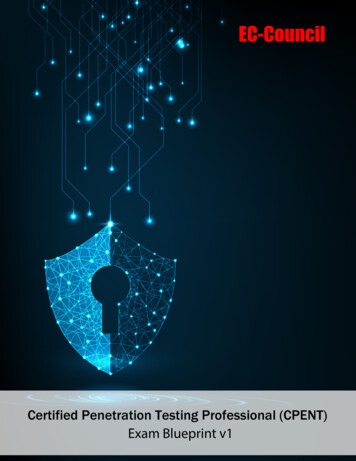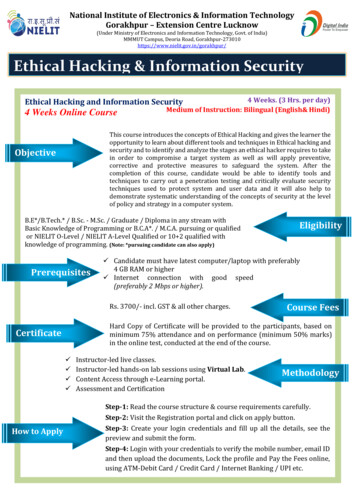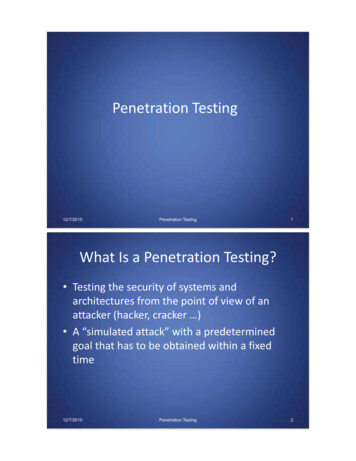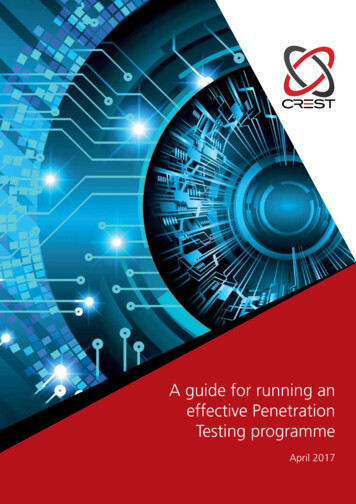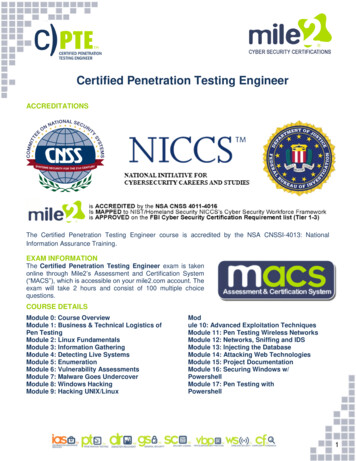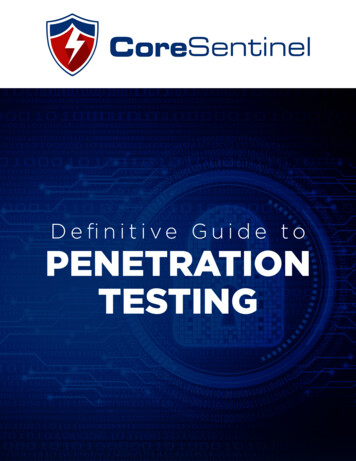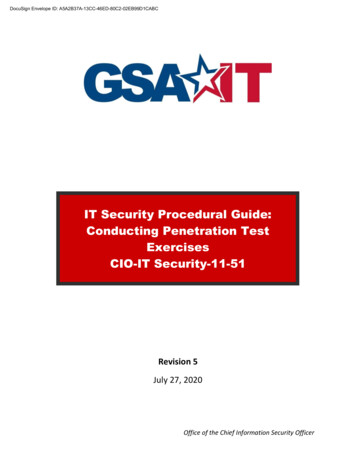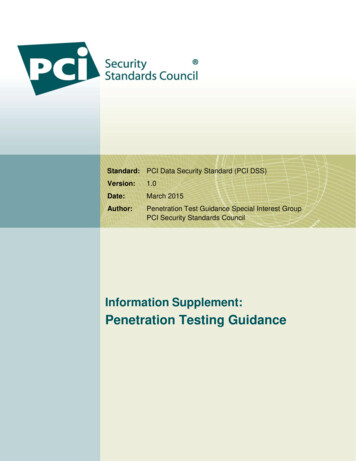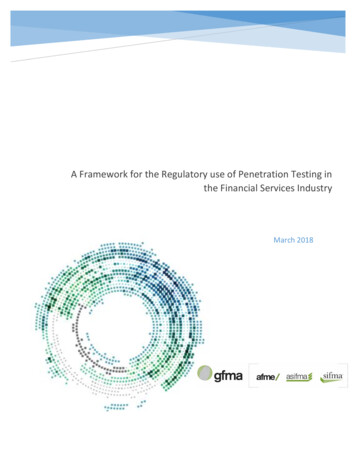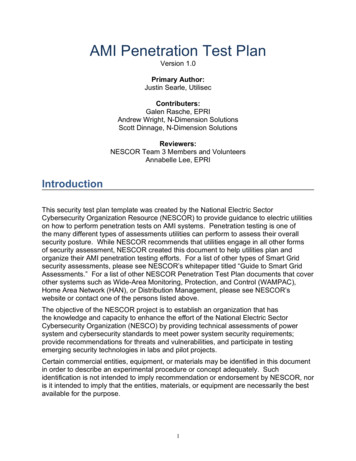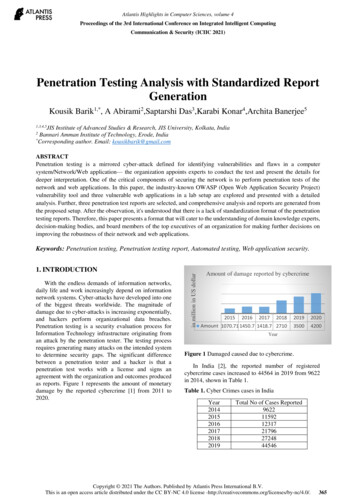
Transcription
Atlantis Highlights in Computer Sciences, volume 4Proceedings of the 3rd International Conference on Integrated Intelligent ComputingCommunication & Security (ICIIC 2021)Penetration Testing Analysis with Standardized ReportGenerationKousik Barik1,*, A Abirami2,Saptarshi Das3,Karabi Konar4,Archita Banerjee51,3,4,5JIS Institute of Advanced Studies & Research, JIS University, Kolkata, IndiaBannari Amman Institute of Technology, Erode, India*Corresponding author. Email: kousikbarik@gmail.com2ABSTRACTPenetration testing is a mirrored cyber-attack defined for identifying vulnerabilities and flaws in a computersystem/Network/Web application— the organization appoints experts to conduct the test and present the details fordeeper interpretation. One of the critical components of securing the network is to perform penetration tests of thenetwork and web applications. In this paper, the industry-known OWASP (Open Web Application Security Project)vulnerability tool and three vulnerable web applications in a lab setup are explored and presented with a detailedanalysis. Further, three penetration test reports are selected, and comprehensive analysis and reports are generated fromthe proposed setup. After the observation, it's understood that there is a lack of standardization format of the penetrationtesting reports. Therefore, this paper presents a format that will cater to the understanding of domain knowledge experts,decision-making bodies, and board members of the top executives of an organization for making further decisions onimproving the robustness of their network and web applications.Keywords: Penetration testing, Penetration testing report, Automated testing, Web application security.With the endless demands of information networks,daily life and work increasingly depend on informationnetwork systems. Cyber-attacks have developed into oneof the biggest threats worldwide. The magnitude ofdamage due to cyber-attacks is increasing exponentially,and hackers perform organizational data breaches.Penetration testing is a security evaluation process forInformation Technology infrastructure originating froman attack by the penetration tester. The testing processrequires generating many attacks on the intended systemto determine security gaps. The significant differencebetween a penetration tester and a hacker is that apenetration test works with a license and signs anagreement with the organization and outcomes producedas reports. Figure 1 represents the amount of monetarydamage by the reported cybercrime [1] from 2011 to2020.in million in US dollar1. INTRODUCTIONAmount of damage reported by cybercrime201520162017201820192020Amount 1070.71 1450.7 1418.7 271035004200YearFigure 1 Damaged caused due to cybercrime.In India [2], the reported number of registeredcybercrime cases increased to 44564 in 2019 from 9622in 2014, shown in Table 1.Table 1. Cyber Crimes cases in IndiaYear201420152016201720182019Total No of Cases Reported96221159212317217962724844546Copyright 2021 The Authors. Published by Atlantis Press International B.V.This is an open access article distributed under the CC BY-NC 4.0 license 5
Atlantis Highlights in Computer Sciences, volume 4As per the penetration testing survey conducted in2020 [3], 72% of the responder noted they use opensource/ freeware tools. Nearly 50% of respondersreported commercial tools that open source tools may notoffer. Reporting was the most prevalent factor [3] whileselecting tools for penetration testing. As per survey [3],69% of the responder listed reporting as an essentialfactor, maybe due to compliance requirements, whichoften require extensive documentation to comply withregulation and industry needs. 64% of the respondentslisted multi-vector testing capabilities as the secondimportant factor in the penetration testing report.Expert security consultants conduct penetrationtesting as complex manual processes. However, themanual penetration testing process is time-consuming,expensive, and dependent on the skill set of thepenetration tester. Therefore, expert professionalsdevelop an automated tool so that non-expert users cansupplant the penetration team to view the current securitystatus. Table 2 shows the comparison between manualand automatic penetration testing [4,5].Table 2. Comparison between manual and automatedpenetration ManualManual nonstandardprocess, high cost incustomization.process, high cost incustomization.Dependencies on thepublic database andessential to maintainthe databasemanually.ReportingManual process ofcollection of data.NetworkIdentificationNo change is neededin systems.AuditingSlow, complex tomanage, and ofteninaccurate process.ExploitDevelopmentandManagementMaintaining anexploit database isvery difficult, andpublic exploits canbe unsafe to run.TrainingMorestraightforward, totrain users comparedto manual testing.AutomatedStandard process,fast in time.Updates areavailable for theattack database.Customization ofreports based onrequirements andavailablecentrally.Different systemsmodifications arerequired.Records allactivityautomatically.Product vendorsmaintain exploitsand are easier tomanage. Inaddition, exploitsare developed byprofessionalexperts andthoroughly tested.Training can becustomized buttime-consuming.In this context, the motivation of this work deals withstudying different open source tools, web vulnerablewebsites online available for freeware testing. A labenvironment has been set up to experiment with variousattacks, generate reports on a real-time basis. Further,different penetration testing reports are studied, availableonline. Based on common gaps identified in reportingformats, comparative analysis and a standardizedpenetration testing report have been proposed.The remaining paper is formulated as follows.Section I discusses the related works. In section IIdiscussed methodology, set up a lab environment.Section III performed detailed analysis, captured andpresented this paper. A standard penetration report basedon findings has been proposed. Finally, in IV, the paperhas been concluded and provided various directions forfuture research.2. RELATED WORKKwiatkowska et al. [6] highlighted the significance ofeach tired of the web, mainly security with its servicepoint and sufficient security check at the service point.Touseef et al. [7] proposed a complete study of webvulnerability measuring and recognizing relevantdatasets. Khera et al. [8] examined and presented thelifecycle of the VAPT process and VAPT tools. Theyconcentrate on several organization levels for adaptationrequirements of security standards to defend variouscybersecurity threats. Alanda et al. [9] highlightedvulnerability and techniques used to find an exposure inmobile-based penetration testing using the OWASP.Yulianton et al. [10] suggested a framework foridentifying web vulnerabilities using taint analysis andblack-box testing. Jinfeng et al. [11], a case study isconducted for vulnerability scanners using the OWASPtool. Helmiawan et al. [12] examined the security of theweb using Open Web Application Security Project 10.Wijaya et al. [13] suggested a web-based dashboard formonitoring penetration testing based on OWASPstandards. The dashboard is made using PHPprogramming languages tools and can display applicationvulnerabilities based on their frequency of occurrence.Lala et al. [14] highlighted the mitigation process ofvulnerabilities in web applications using configurationchanges, coding, and security updates.Shebli et al. [15] explained the importance ofpenetration testing, components considered, the survey oftools and procedures resulted while conductingpenetration testing. Zakaria et al. [16] proposed apenetration testing format to understand theorganization's security professional and uppermanagement needs. Shebli et al. [15] explained theimportance of penetration testing, componentsconsidered, the survey of tools and procedures resultedwhile conducting penetration testing. Zakaria et al. [16]suggested a penetration testing format to understand the366
Atlantis Highlights in Computer Sciences, volume 4organization's securitymanagement needs.professionalandupperHardware3. METHODOLOGYThis study begins with selecting tools for this work—first, popular tools are chosen in the cybersecuritydomain. Second, popular open source tools are studiedbased on Gartner Magic Quadrant for application securitytesting [17,18,19]. Unfortunately, due to the lack of alicensed version of the tool, it was not feasible to continueresearch. Therefore, only freeware tools, i.e., OWASPZAP [20], are used in this work. Table 3 represents theversion and other parameters of the OWASP tool [31-34].Software8 GBRAM,IntelCore i52.7 GHzOWASP1GBRam, 1CPU,(Virtual)1GBRam, 1CPU,(Virtual)1GBRam, 1CPU,(VirtualDVWAGoogleGruyereBWAPPThe process followed while detecting attackerpatterns and evaluating vulnerable web applications isshown in Figure 3.Table 3. Parameter of OWASP updateOWASP ZAPFreewareApache2.10.0ProxyJune2021Two computers are used, one for the attacker andanother one for the server. Both connected physicallythrough wire via a switch, shown in Figure 2. The servercomputer uses Windows 10 Professional operatingsystem with Intel (R) Core (TM.) i7 5GHz, 16 GB RAMprocessor. In addition, three virtual machines areinstalled for running web servers (named web server 1,web server 2, and web server 3). The attacker computeruses Windows 10 Professional operating system withIntel Core (R) Core (TM.) i5 2.20GHz, 8 GB. of RAMprocessor. Table 4 represents each component in theproposed method.Figure 3 Process flow for detection and reporting.3.1. ToolOWASP ZAP: It is a freeware tool extensivelyaccepted concerning automated vulnerability detection inweb applications. It is a non-profit organization, whichserves to enhance security in software. The 2.10.0 versionof OWASP ZAP is utilized for this work, with defaultscan profiles [35-38].3.2. Vulnerable Web ApplicationFigure 2 Proposed lab setup.Table 4. Test environment featuresOSAttackerWindows 10ProfessionalWebServer 1UbuntuServer14.04.6LTS x86WebServer 2UbuntuServer14.04.6LTS x86WebServer 3UbuntuServer14.04.6LTSx86Three types of vulnerable web applications, namelyDVWA [21], Google Gruyere [22], and BWAPP [23], areemployed in this work. DVWA (Damn Vulnerable WebApplication) is a web application based on vulnerabilityused by security professionals to test skillsets and toolsin a legal environment. Google Gruyere is a webapplication that is thoroughly discovering bugs andlearning ways to fix them. Finally, BWAPP (Buggy WebApplication) is an open source web application and usesthe penetration tester to find and prevent web367
Atlantis Highlights in Computer Sciences, volume 4vulnerabilities. The analyses discussed above areperformed for education purposes only.[39-42]Vulnerability4. RESULT AND DISCUSSIONThe experimental assessment is detailed and showed theweb vulnerability identified in Table 5, Table 6, andTable 7.Table 5. Web vulnerability detected inside DVWAVulnerabilityCross-Domain MisconfigurationCSP: style-src unsafe-inlineCSP: Wildcard DirectiveVulnerable JS LibraryX-Frame-Options Header Not SetIncomplete or No Cache-control andPragma HTTP Header SetX-Content-Type-OptionsHeaderMissingInformation Disclosure - SuspiciousCommentsTable 7. Web vulnerability detected inside BWAPPNo ofinstances1933126X-Frame-Options Header Not SetX-Content-Type-OptionsMissingHeaderNo ofinstances44After evaluating BWAPP, vulnerable webapplications employing the OWASP ZAP tool, two typesof vulnerability are identified, i.e., X-Frame-OptionsHeader Not Set and X-Content-Type-Options HeaderMissing.Figure 4 represents the overview of the OWASP ZAPtool, and Figure 5 illustrates the analysis of Vulnerabilityin DVWA web application; Figure 6 shows analysis ofVulnerability in Google Gruyere web application.162After evaluating DVWA vulnerable web applicationsutilizing the OWASP ZAP tool, the Cross-DomainMisconfiguration and X-content-type-options headermissing amount to the maximum number of instances.Therefore, the shared vulnerability revealed by ration, CSS, information disclosure, etc.Figure 4 Overview of OWASP.Table 6. Web vulnerability detected inside GoogleGruyereVulnerabilityCross Site Scripting (Reflected)X-Frame-Options Header Not SetAbsence of Anti-CSRF TokensCookie No HttpOnly FlagCookie Without SameSite AttributeCookie Without Secure FlagIncomplete or No Cache-control andPragma HTTP Header SetX-Content-Type-Options Header MissingCharset Mismatch (Header Versus MetaContent-Type Charset)Information Disclosure - SuspiciousCommentsTimestamp Disclosure - UnixNo ofinstances160322262Figure 5 Analysis of Vulnerability in DVWA.72711After assessing Google Gruyere's vulnerable webapplications utilizing the OWASP ZAP tool, the commonvulnerabilities identified are cross-site scripting, charsetmismatch, CSRF, time disclosure, etc.Figure 6 Analysis of Vulnerability in Google Gruyere.368
Atlantis Highlights in Computer Sciences, volume 4In this section, the discovery of web vulnerabilityusing open source penetration testing tools is highlighted.The primary intention is to aid security professionals intesting their skill set and tools in a legal environment.Security) institute [29], four primary penetration reportwriting phases are shown in Fig 10. An ancient proverbin the consulting business: "If you do not document it, itdid not happen" [30].Additionally, two online open source penetrationtesting tools are tested, i.e., pentest tools [24] andForgenix [25], with three existing web-based vulnerabledatabases. Reports generated using the OWASP tool arerepresented in Figure 7.Figure 7 Generation of the report using OWASP.Figure 8 - 9 presents reports generated subsequentlyfrom tools using three existing vulnerability applicationsused in the current setup.Figure 10 Penetration testing report-writing phases.Based on the online penetration report andexperimental setup study, a penetration test report hasbeen proposed that should comprise the below-specifiedobjectives.Executive SummaryThis section represents a comprehensive outline ofthe report. In addition, it contains a high-level meeting ofthe penetration test, findings, observations, and forms forthe executive members.1.Scope of work: This section defines the overallFigure 8 Generation of the report using pentest.scope of work.2.Objectives of work: The aim is to connect thepenetration test report outcomes based on the scope of thework and direction.3.Timeline: It shows the penetration testing start andend date, which should be included.4.Summary of findings: It represents the overallidentified risks based on priorities in Summary.5.Summary of recommendation: This sectionrepresents the high level of advice for the targetorganizations based on identified risks.MethodologyFigure 9 Generation of the report using Forgenix.There is no standard format of penetration testingreport from the study as mentioned above. Further, threedifferent penetration test reports available online [26],[27], [28] are studied. No standardized report format forthe above studies is discovered, shown in Annexure 1.According to the SANS (SysAdmin, Audit, Network, andThis section outlines the steps to be pursued to collectinformation, analysis, and the method used to measurethe risk of vulnerability.1.Planning: In this phase, the requirements ofpenetration testing are identified.369
Atlantis Highlights in Computer Sciences, volume 42.Exploitation: The penetration tester maps all thepossible vulnerabilities and sees to what extent they canget into the environment.3.Reporting: In this phase, the penetration tester reportsall the detected vulnerabilities.Detailed FindingsThis section represents complete information concerningeach finding; results can be described as a table, pie chart,bar graph, diagrams, etc.1.Details of vulnerability: For all vulnerabilities, thedescription should be conferred about the source of thevulnerabilities, impact, and the likelihoods to beexploited.2.Impact: It outlines the effects of vulnerability bythreats.3.Likelihood: It represents the probability ofoccurrence of the threat.4.Recommendations: The penetration tester presentsgood recommendations on the risk rating and severity ofthe asset based on the outcome and discoveries. [42-44]5. CONCLUSIONSeveral state-of-the-art penetration testing tools havebeen studied and explored in their report formats. Thispaper highlights the differences in reports produced byvarious tools. A new standard format of report generationfor pen testing is proposed based on the survey carriedout. This standardized format will facilitateunderstanding of the network vulnerabilities by thesecurity professionals irrespective of the pen testing toolused. The tool collects the data in any format andconverts it to the standardized format as per the proposal.The future scope is to construct a penetration testing tooland generate the report as the proposed idea.REFERENCES[1] s/[2] National Crime Investion Bureau, The governmentof India, https://ncrb.gov.in/[3] Penetration Testing Report, 2020, Coresecurity.https://www.coresecurity.com/[4] Y. Stefinko, A. Piskozub and R. Banakh, "Manualand automated penetration testing. Benefits anddrawbacks. Modern tendency," 2016 13thInternational Conference on Modern Problems ofRadio Engineering, Telecommunications andComputer Science (TCSET), Lviv, 2016, pp. 488491. DOI: 10.1109/TCSET.2016.7452095.[5] Mirjalili, Mahin, Alireza Nowroozi, and MitraAlidoosti. "A survey on web penetrationtest."International Journal in Advances in ComputerScience 3.6 (2014). ISSN: 2322-5157.[6] Kachhwaha R., Purohit R. (2019) RelatingVulnerability and Security Service Points for WebApplication Through Penetration Testing. In:Panigrahi C., Pujari A., Misra S., Pati B., Li KC.(eds) Progress in Advanced Computing andIntelligent Engineering. Advances in IntelligentSystems and Computing, vol 714. Springer,Singapore.DOI:10.1007/978-981-13-0224-4 4.[7] Touseef, P., Alam, K. A., Jamil, A., Tauseef, H.,Ajmal, S., Asif, R., . & Mustafa, S. (2019, July).Analysis of automated web application securityvulnerabilities testing. In Proceedings of the 3rdInternational Conference on Future Networks andDistributedSystems (pp.1-8),DOI:10.1145/3341325.3342032.[8] Khera, Y., Kumar, D., & Garg, N. (2019, February).Analysis and Impact of Vulnerability Assessmentand Penetration Testing. In 2019 InternationalConference on Machine Learning, Big Data, Cloudand Parallel Computing (COMITCon) 4.[9] Alanda, A., Satria, D., Mooduto, H. A., &Kurniawan, B. (2020, May). Mobile ApplicationSecurity Penetration Testing Based on OWASP.In IOP Conference Series: Materials Science andEngineering (Vol. 846, No. 1, p. 012036). 0] Yulianton, H., Trisetyarso, A., Suparta, W., Abbas,B. S., & Kang, C. H. (2020, July). Web ApplicationVulnerability Detection Using Taint Analysis andBlack-box Testing. In IOP Conference Series:Materials Science and Engineering (Vol. 879, No. 1,p. 012031). IOP Publishing.DOI:10.1088/1757899X/879/1/012031.[11] Li, Jinfeng. "Vulnerabilities mapping based onOWASP-SANS: a survey for static applicationsecurity testing (SAST)." Annals of 6/AETiC.2020.03.001.[12] Helmiawan, M. A., Firmansyah, E., Fadil, I.,Sofivan, Y., Mahardika, F., & Guntara, A. (2020,October). Analysis of Web Security Using OpenWeb Application Security Project 10. In 2020 8thInternational Conference on Cyber and IT ServiceManagement(CITSM) 0
Atlantis Highlights in Computer Sciences, volume 4[13] Wijaya, Y. S., & Ramadhani, I. (2020). Web-BasedDashboard for Monitoring Penetration TestingActivities Based on OWASP Standards. JurnalIlmiah Teknik Elektro Komputer dan Informatika(JITEKI), 6(1),36-41.DOI:10.26555/jiteki.v6i1.17019.[31] K. Yu, L. Tan, L. Lin, X. Cheng, Z. Yi and T. Sato,"Deep-Learning-EmpoweredBreastCancerAuxiliary Diagnosis for 5GB Remote E-Health,"IEEE Wireless Communications, vol. 28, no. 3, pp.54-61,June2021,doi:10.1109/MWC.001.2000374.[14] Lala, S. K., Kumar, A., & Subbulakshmi, T. (2021,May). Secure Web development using OWASPGuidelines. In 2021 5th International Conference onIntelligent Computing and Control Systems(ICICCS) 2179.[32] K. Yu, Z. Guo, Y. Shen, W. Wang, J. C. Lin, T. Sato,“Secure Artificial Intelligence of Things for ImplicitGroup Recommendations”, IEEE Internet of ThingsJournal, 2021, doi: 10.1109/JIOT.2021.3079574.[15] Al Shebli, H. M. Z., & Beheshti, B. D. (2018, May).A study on penetration testing process and tools.In 2018 IEEE Long Island Systems, Applicationsand Technology Conference (LISAT) (pp. 1-7).IEEE.DOI: 10.1109/LISAT.2018.8378035.[16] Zakaria, M. N., Phin, P. A., Mohmad, N., Ismail, S.A., Kama, M. N., & Yusop, O. (2019, December).A Review of Standardization for PenetrationTesting Reports and Documents. In 2019 6thInternational Conference on Research andInnovation in Information Systems (ICRIIS) (pp. 15),DOI: 10.1109/ICRIIS48246.2019.9073393.[17] Gartner Application Security Testing (AST)Review and Ratings.[18] The 2020 Gartner Magic Quadrant for ApplicationSecurity Testing.[19] A Tirosh, M. Horvath and D. Zumerle, "MagicQuadrant forApplication Security Testing,"Gartner, 18 April 2019. OWASP ZAP.[20] https://owasp.org/www-project-zap/[21] https://dvwa.co.uk/[23] http://www.itsecgames.com/[24] https://pentest-tools.com[25] https://foregenix.com[26] Pen Test Report, January 1,2020, PurpleSec.Test[34] L. Zhen, A. K. Bashir, K. Yu, Y. D. Al-Otaibi, C. H.Foh, and P. Xiao, “Energy-Efficient RandomAccess for LEO Satellite-Assisted 6G Internet ofRemote Things”, IEEE Internet of Things Journal,doi: 10.1109/JIOT.2020.3030856.[35] L. Zhen, Y. Zhang, K. Yu, N. Kumar, A. Barnawiand Y. Xie, "Early Collision Detection for MassiveRandom Access in Satellite-Based Internet ofThings," IEEE Transactions on VehicularTechnology, vol. 70, no. 5, pp. 5184-5189, May2021, doi: 10.1109/TVT.2021.3076015.[36] L. Tan, K. Yu, A. K. Bashir, X. Cheng, F. Ming, L.Zhao, X. Zhou, “Towards Real-time and EfficientCardiovascular Monitoring for COVID-19 Patientsby 5G-Enabled Wearable Medical Devices: A DeepLearning Approach”, Neural Computing andApplications, 2021, https://doi.org/10.1007/s00521021-06219-9[37] Puttamadappa, C., and B. D. Parameshachari."Demand side management of small scale loads in asmart grid using glow-worm swarm optimizationtechnique." Microprocessors and Microsystems 71(2019): 102886.[22] https://google-gruyere.appspot.com/[27] Real VNC, "PenetrationResponse", 2019.[33] H. Li, K. Yu, B. Liu, C. Feng, Z. Qin and G.Srivastava, "An Efficient Ciphertext-PolicyWeighted Attribute-Based Encryption for theInternet of Health Things," IEEE Journal ofBiomedical and Health Informatics, 2021, doi:10.1109/JBHI.2021.3075995.Reportand[28] Offensive Security Services, LLC, Penetration TestReport : Mega Corp One,2013.[29] SANS Institute, "Writing a Penetration TetingReport", 2010.[30] Lam,K.,Smith,B.,&LeBlanc,D.(2004). Assessing network security. MicrosoftPress.[38] Parameshachari, B. D., H. T. Panduranga, and Silvialiberata Ullo. "Analysis and computation ofencryption technique to enhance security of medicalimages." In IOP Conference Series: MaterialsScience and Engineering, vol. 925, no. 1, p. 012028.IOP Publishing, 2020.[39] Subramani, Prabu, Ganesh Babu Rajendran, JewelSengupta, Rocío Pérez de Prado, andParameshachari Bidare Divakarachari. "A block bidiagonalization-based pre-coding for ommunication system." Energies 13, no. 13(2020): 3466.371
Atlantis Highlights in Computer Sciences, volume 4[40] Hu, Liwen, Ngoc-Tu Nguyen, Wenjin Tao, Ming C.Leu, Xiaoqing Frank Liu, Md Rakib Shahriar, andSM Nahian Al Sunny. "Modeling of cloud-baseddigital twins for smart manufacturing with MTconnect." Procedia manufacturing 26 (2018): 11931203.[41] Nguyen, Tu N., Bing-Hong Liu, Nam P. Nguyen,and Jung-Te Chou. "Cyber security of smart grid:attacks and defenses." In ICC 2020-2020 IEEEInternational Conference on Communications(ICC), pp. 1-6. IEEE, 2020.[42] Pham, Dung V., Giang L. Nguyen, Tu N. Nguyen,Canh V. Pham, and Anh V. Nguyen. "Multi-topicmisinformation blocking with budget constraint ononline social networks." IEEE Access 8 (2020):78879-78889.[43] Arun, M., E. Baraneetharan, A. Kanchana, and S.Prabu. "Detection and monitoring of the asymptoticCOVID-19 patients using IoT devices andsensors." International Journal of PervasiveComputing and Communications (2020).[44] Kumar, M. Keerthi, B. D. Parameshachari, S. Prabu,and Silvia liberata Ullo. "Comparative Analysis toIdentify Efficient Technique for Interfacing BCISystem." In IOP Conference Series: MaterialsScience and Engineering, vol. 925, no. 1, p. 012062.IOP Publishing, 2020.Annexure 1.PenetrationTestingReport262728Executive SummarySSucmSumoma maryTiOb pryofmejec eofrecolintiv ofout mmeeewco ndatiorme onks MethodologyPlanningExploitationReporting Details of findingsDetails ofvulnerabilitiesImpactfactorLikelihood Riskevaluation Recommendations ScanningResults onresuifltsany References 372
Expert security consultants conduct penetration testing as complex manual processes. However, the manual penetration testing process is time-consuming, expensive, and dependent on the skill set of the penetration tester. Therefore, expert professionals develop an automated tool so that non-expert users can supplant the penetration team to view .
